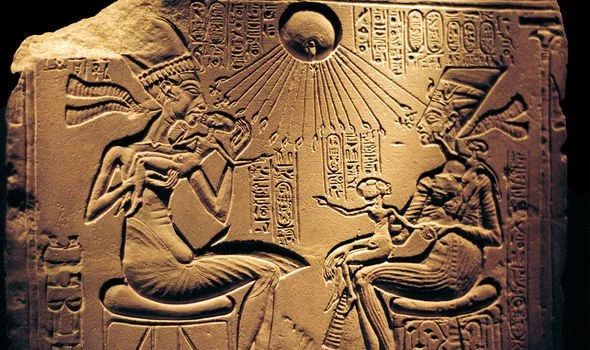Who was Akhenaten?
Akhenaten was an Egyptian pharaoh who ruled for 17 years during the 18th dynasty. He is best known for his attempt to radically change Ancient Egyptian religion by replacing the traditional pantheon of gods with one single god, Aten. This event is now referred to as the Amarna Revolution. Although it did not last long after Akhenaten’s death, it had a profound and lasting effect on Ancient Egyptian religious beliefs and culture. You will know more about the Ancient Egyptian religion and culture by joining our Egypt travel packages.
Pharaoh Akhenaten Family
In addition to his wife, Nefertiti, and their six daughters, Akhenaten also fathered Tutankhamun with one of his sisters. It is likely that he had many other children as well, although we know of no others for certain.
Akhenaten’s father was Pharaoh Amenhotep III, who ruled Egypt for over three decades. His mother was Queen Tiye, they have huge statues at the entrance of the Egyptian Museum the main attraction in Cairo day tours, who was very influential at the court. Amenhotep and Tiye had eight children together, including Akhenaten’s older sister Mutemwiya.
Akhenaten’s grandfather was Thutmose IV, who famously broke with tradition by marrying a commoner rather than a royal princess. This unusual marriage may have been the reason why Amenhotep III married his own half-sister, Mutemwiya. Listen to Akhenaten’s full history in detail from our guide in Egypt classic tours.
Akhenaten’s Early Life
Not much is known about Akhenaten’s early life. He was the son of Amenhotep III and Queen Tiye and became the crown prince around the age of five. He married his half-sister, Queen Nefertiti, and they had six daughters together.
Akhenaten was a quiet and studious young man, preferring to spend his time reading and writing rather than engaging in sports or other activities like his father and grandfather before him. His father Amenhotep III seems to have been a bit of a spared heir, as there are many records of him during his own reign. You can visit the temple of Aten (The only God in Akhenaten’s era) in Al Amarena on your luxury tours in Egypt to know more about the ancient Egyptian religious ritual.
In contrast, very few documents survive from Akhenaten’s early years. This may be because he was not expected to become pharaoh and so there was no need to keep records of his life, or it could be that most of the records were destroyed after he came to power and instituted sweeping changes to Egyptian religion and society.
Akhenaten’s rise to power
Born a prince, Akhenaten was heir to the Egyptian throne. He ascended to the throne at the death of his father, Amenhotep III. His reign was one of the most controversial in Egyptian history. He is best known for his religious reforms which included the worship of a single god, Aten, and the construction of a new capital city, Akhetaten. These changes were short-lived and after his death, Egypt returned to its traditional religion and ways. Know more about the ancient Egyptian gods while you are wandering between the temples in Luxor and Aswan excursions.
The Fall of Akhenaten
Akhenaten was one of the most controversial pharaohs in Egyptian history. He is best known for his attempt to radically reform Egyptian religion by replacing the traditional pantheon of gods with the sun god Aten, his status is in Karnak Temple, visit it during your Luxor day tours. This religious change was short-lived, and after Akhenaten’s death, Egypt returned to its traditional religion.
Akhenaten’s reign was a time of great turmoil for Egypt. In addition to his religious reforms, Akhenaten also presided over a period of political and economic upheaval. The country was beset by foreign invaders, internal rebellions, and natural disasters. All of this took a toll on Akhenaten’s health and mental state, and he became increasingly reclusive and paranoid in the final years of his life.
Akhenaten’s death was followed by a period of instability and chaos. His successors were unable to maintain control over Egypt, and it wasn’t until the reign of Tutankhamun that stability was restored. Even then, Tutankhamun’s reign was plagued by problems, and it wasn’t until the rule of Ramses II that Egypt truly regained its former glory. Gather your family in one of our Egypt family tours to the Egyptian Museum to see the separate room for Tutankhamun’s accessories and a golden mask. Also, you can visit his unique tomb in the Valley of the Kings in Luxor.
King Akhenaten Death and Legacy
Akhenaten’s death was shrouded in mystery and controversy. The exact cause of his death is unknown, but it is believed that he may have died from natural causes or from a plague. His body was never found, and his tomb is still a mystery, but you can visit his tomb in Al Amarena during our Egypt day tours.
Akhenaten’s legacy is also shrouded in mystery. He was a controversial figure during his lifetime, and his reign was short-lived. However, he left a lasting impact on Egyptian culture and religion. He is credited with introducing the concept of monotheism to Egypt, and his reforms had a profound impact on the country. Akhenaten’s legacy continues to be studied and debated by historians and archaeologists today.
The ancient Egyptian Pharaoh Akhenaten was a fascinating figure in history. Though he only ruled for 17 years, he made a significant impact on Egyptian culture and religion. These 10 facts about Akhenaten give us a glimpse into his life and legacy and know more about the Egyptian kings by joining our Egypt tours.




Comment (0)